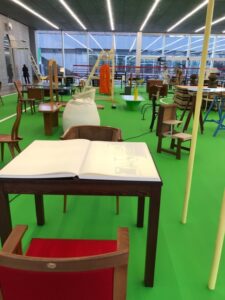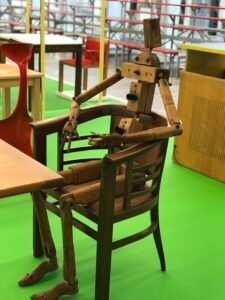
by Liviana Martin in Milan

Before being closed for Covid19, for a few days the Prada Foundation in Milan celebrated the genius of Kafka with an exhibition conceived as a triptych that includes a film, a soundtrack and an installation.
In the novels that make up the Trilogy of Solitude (The Trial, Amerika, The Castle), K. is the initial of the names of the protagonists, the many alter egos of the Czech-born author, Franz Kafka.
These unfinished novels are imbued by a deep sense of solitude, lost memory and anguish, with protagonists crushed by an overwhelming bureaucracy together with the innocent’s sense of guilt, which cannot be expiated, because it cannot be known. In fact K. in The Trial ignores what he is accused of, and his negligence is completely irrelevant to the punishment inflicted in Amerika. Land surveyor K. is exhausted while waiting in vain to be admitted to the fortress (The Castle), due to a series of absurd bureaucratic events.
Orson Welles’ film of The Trial, with a disturbing Anthony Perkins as K. and the director himself in the role of the lawyer, is a powerful black and white representation of a man caught in the gears of the judicial system: enigmatic characters surround K., who meanders around in the desolate, overcrowded environment of the court until the tragic conclusion. Human rationality disappears in the impenetrable universe of the court, while the degradation of every norm is visible in the disorder and sordidness of the surroundings.
The images from the film accompany me to another large space in the Prada Foundation, similar to a fortress, where Tangerine Dream, a German band, evoke the atmosphere of The Castle through magnetic, electronic music.
Today in the lockdown I remember what the landlady in the novel says to the land surveyor K., who doesn’t understand how to gain access to the castle: “Wherever you may be, never forget that you’re the most ignorant person in the village; and be cautious.” I also had this feeling of not understanding what was happening around me, not just because of the often contradictory or incorrect information from the experts and government, but above all because of the climate of anguished expectation: Will there be a cure for this virus? Will it come in the form of a drug? Or a vaccine? I felt like K., helpless but loyal to the rules that I did not always understand.

And finally, to return to the exhibition, the final coup de théâtre: the visionary reconstruction of the ‘great theater of Oklahoma’, cited in the third novel, Amerika, where 16-year-old Karl Rossmann is accused of seducing a waitress and is kicked out of his home by his father and sent to America to rehabilitate. In an America that seems to embody the very idea of boundless freedom, Karl becomes lost. Martin Kippenberger’s installation The Happy End of Franz Kafka’s Amerika refers to the part of the novel in which the protagonist seeks employment in the ‘largest theater in the world’. The German artist recreates a football field, where he inserts over 40 combinations of tables and chairs, with elements of vintage design and flea market furnishings. The aim is to recall the job interviews that could take place around those tables. The title of the installation refers to a happy ending, rare in Kafka’s novels. In reality, the writer describes America not as a land of opportunity (as young Rossmann hoped) but as a world dominated by exploitation and abuse of power.
As the curator Udo Kittelmann points out, the exhibition can be considered a narrative of the ‘darkest areas of human life’, as Walter Benjamin thought applied to Kafka’s work. In the three elements of the triptych, comparable to an altarpiece, the central ‘panel’ is made up of Amerika, and the other two elements form the side panels, defining a vision of the anxieties of life. After all, as Kafka wrote, “… the inconceivable is inconceivable, and that we knew already”.
Volume 34 no 6 July / August 2020

